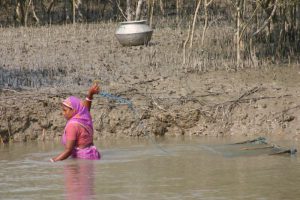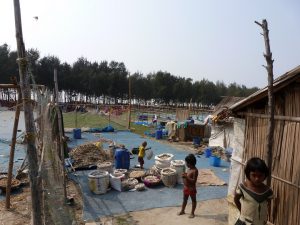The heat wave that killed around 2,500 people in Andhra Pradesh and Telangana in the last week of May 2015 is directly attributable to climate change. Global warming has increased the likelihood of such a heat wave in the region from being a once-in-100-years event to a once-in-10-years event, a tenfold increase in probability. If the pollutants that blanket the sky above Hyderabad and much of the region were removed, such a heat wave may occur once every two years.
These are the three main conclusions of an analysis of the 2015 heat wave carried out by a group of researchers in India and abroad. Karsten Haustein of the University of Oxford, who is part of the group, said the researchers had found “very strong attribution, linking more extreme heat waves to human-induced climate change.” Their study has been submitted for publication in the Bulletin of the American Meteorological Society.
Haustein was speaking at a roundtable. Held in New Delhi on February 28, the roundtable was part of a project called Raising Risk Awareness, being carried out by seven think tanks in India and abroad.
The findings have clear implications for planners in South Asia. For one, they have to be far more ready for extreme heat waves than they are now. On top of that, they have to be aware that if and when pollution from industrial activities and transport is cleaned up, it will lead to stronger heat waves, as it has done in North America and Europe.
The blanket of pollution that envelopes South Asia much of the time does have the effect of preventing some of the sun’s heat from reaching the earth’s surface. This does not mean air pollution is “good” — it kills seven million people a year worldwide and may have an adverse impact on rainfall. What it does mean that is that planners have to be ready for even higher temperatures.
Attribution science
One cutting edge of climate science now is to study individual events such as heat waves, floods or droughts, and attribute it or not attribute it to climate change. This has implications for policymakers — if scientists tell them that a heat wave is due to climate change and that its frequency is likely to increase, they have to prepare accordingly. It has implications for the insurance industry for the same reason. It also has implications for international climate negotiations, in the arena of loss and damage. Once there is scientific evidence linking a particular storm or flood or heat wave to climate change, developing countries can demand compensation from the developed countries that have caused most of the climate change since the start of the Industrial Age.
In this project, the scientists had studied two events in India – the very heavy rainfall in Chennai on 1 December 2015, and the Andhra-Telangana heat wave. Krishna Achuta Rao of Indian Institute of Technology Delhi, co-researcher in the Chennai study, said that his team could not find any reason to attribute the rainfall to climate change.
See: Last year’s Chennai deluge not due to climate change
The heat wave, however, was clearly due to climate change, the scientists said after studying masses of weather data and running iterations of climate models.
Policy implications
Will these findings change anything on the ground? Not unless the scientists can get even more specific, and forecast the month when the heat wave will take place or the number of days it will go on, said Nagendra K. Biyani of the disaster management department in the Andhra Pradesh government. “We plan for heat waves anyway,” he told the roundtable. “A generic mention of the role of climate change in a heat wave does not help in that planning. We need something specific.”
![Heat waves in summer inevitably lead to water shortages in many places [image by Rajesh Pamnani]](/wp-content/uploads/2017/03/HeatWave2.jpg)
Akhilesh Gupta, climate change head in the Department of Science and Technology (DST), pointed to the same problem. He said Indian scientists could now provide crucial information on storms, heat waves, floods or droughts, but that was neither being communicated effectively to other ministries, nor to the people. “We can’t work in isolation between DST, MOES (Ministry of Earth Sciences, which is the parent organisation of the India Meteorological Department, IMD), MOEFCC (Ministry of Environment, Forests and Climate Change). The IMD state centres and the DST state climate change cells must work together.”
Heat index
While acknowledging that communication and coordination are crucial, scientists are going ahead with their work. Another study by Achuta Rao, with Michael Wehner, Dáithí Stone and Hari Krishnan in Lawrence Berkeley National Laboratory and Federico Castillo in University of California at Berkeley, pointed out that high humidity often worsens the effect of a heat wave.
The May 2015 heat wave in Andhra Pradesh and Telangana was followed by a heat wave in Karachi that killed at least 700 people, though the temperatures in Pakistan’s largest city were at least five to six degrees lower than in south-central India. The key reason was a relative humidity of 35-70% in Karachi, far higher than the 20% recorded at most weather stations in Andhra Pradesh and Telangana.
This is known, and weather experts in North America and Europe have developed what is called a heat index, a combination of temperature, relative humidity and other factors. However, it is not applicable in South Asia. Scientists are now working on developing a heat index that will be useful to policymakers.
Attribution science is in its infancy, but its utility to policymakers is already apparent, as long as the scientists come up with their results quickly after a heat wave or a storm or a similar event, and as long as these results are communicated without any delay to policymakers and people.
![<p>A woman carries home a pot of water, while taking a shortcut across the dry bed of the Usmansagar lake, in Andhra Pradesh [image by Sherwin Crasto / American Center, Mumbai]</p>](https://dialogue.earth/content/uploads/2017/03/HeatWave1.jpg)








